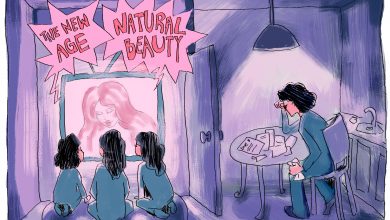Feminism 101: What is Islamophobia?

Illustration by Maddy Pease
As the West (i.e., Europe, Canada, and the USA) becomes increasingly diverse, challenges to dominant ideologies become more and more common. Taking into consideration the current state of global affairs and the growing number of Muslim migrants traveling to Euro-America, Islam has become a point of contention in not only politics but also in feminism.
One of the negative results of this demographic change is a rising amount of anti-Muslim sentiment, also known as Islamophobia. Though there are multiple definitions of the term thrown around, Gallup most clearly describes it as “an exaggerated fear, hatred, and hostility toward Islam and Muslims that is perpetuated by negative stereotypes resulting in bias, discrimination, and the marginalization and exclusion of Muslims from social, political, and civic life.”
These attitudes, along with inflammatory rhetoric, often lead to violence, apathy, and scapegoating by Western populations. This in turn perpetuates a dangerous cycle of alienation and marginalization for non-white, non-Christian people, especially women, and particularly for those who wear hijab. The case of the Muslim ban is the most recent and visible example of Islamophobia enacted in the form of policy.
Within feminism specifically, Islam and women are often seen as being at odds with one another; Muslims are often thought to be incapable of being feminists at all. This often results in either hurtful microaggressions or flatout bigotry. Regardless of their form, however, these behaviors are an embodiment of Islamophobia masked as concern or the desire to “save” Muslim women from their own cultures. Typically, it’s expressed with condescension and a deep-rooted white-savior complex.
This brand of white, orientalist feminism seems to forget that Muslim women have voices and are autonomous beings, not helpless victims of male barbarism at the hands of their own religion. In this way, Islamophobia becomes a mechanism of Western ideology to dehumanize people and excuse colonialism and imperialism. By painting Muslims, especially Muslim men, as dangerous, violent misogynists, it’s easier to validate and rationalize countless drone strikes, coups, and wars in Muslim-majority countries.
Additionally, Islamophobia is used to redirect attention away from Western patriarchy, including our pervasive rape culture and systemic sexism. When we focus largely on injustices in other parts of the world, we distract from their overwhelming prevalence in our own societies. These issues then appear to be overcome by the West long ago.
However, considering that in the United States, one in five women will be a victim of sexual assault, Congress repeatedly attempts to limit reproductive rights, and misogynoir (i.e., the specific hatred towards Black women in America) continues to saturate American social life, it’s probably safe to say we are far from an egalitarian utopia.
To put it plainly, women in both the “East” and “West” face oppression from different forms of patriarchy, but this political hatred of a religion does more damage to the women it claims to protect. It overlooks years of Islamic feminism and ignores countless Muslim intersectional feminists in media (e.g., QueerMuslimProject, The Fatal Feminist, #GoodMuslimBadMuslim, Muslim Girl). Not to mention, it refuses to acknowledge the actual desires and needs of Muslim women themselves.
To truly support Muslim women, their voices should be amplified and enfranchised, not muzzled by people who claim to care about their “liberation” above all else. Otherwise, the oppression is not eliminated. One patriarchy is simply swapped for another.




